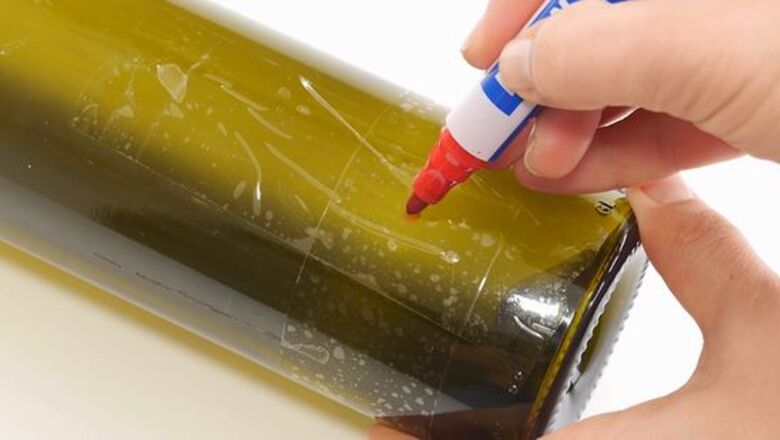
views
- Apply masking tape to the surface of the bottle, and use a marker to indicate where you want the hole. Moisten the spot with oil or a spritz of water.
- Use a carbide or diamond drill bit about 1⁄8–3⁄32 in (3.2–2.4 mm) in diameter. Gently press the bit perpendicularly to the bottle.
- Activate the drill at a low RPM and press the bit into the glass, boring a hole all the way through. Then soften the edges of the hole with sandpaper.
Drilling a Hole into Glass
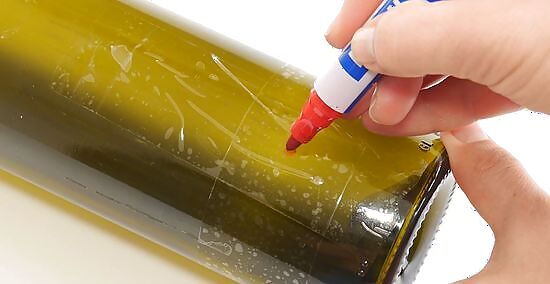
Tape over the glass and mark the hole’s location with a marker. Cover the area where you’ll drill into the glass with masking tape, which helps provide traction to the drill bit so that it doesn’t slip on the slick glass. Then, use a marker to mark on the tape where you want to drill into the bottle to lend you some more accuracy. Or, use packing tape, painter’s tape, medical tape, or another textured type of tape if you don’t have any masking tape on hand.
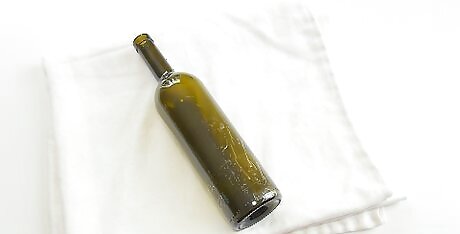
Place the bottle on a folded towel or similar makeshift pad. Set the bottle on a surface with plenty of traction to ensure that it doesn’t slide around as you drill into it. Any kind of broad, soft item with a little give will work here—it could be a seat cushion, a scrap piece of carpet or foam, or even an old t-shirt. Lay the bottle flat against your makeshift pad with the taped side facing up. For added security, use a table-mounted vise to secure the bottle to your work surface. You’ll have the easiest time drilling your bottle when it’s resting on a work surface that’s around waist- or chest-high.Warning: If you attempt to drill into the bottle while it’s resting directly against a hard-topped table or workbench, there’s a chance that it could roll, slide, or shift.
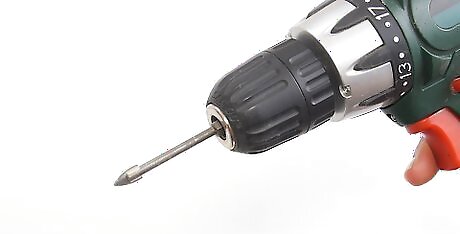
Fit a power drill with a small spear-tipped carbide or diamond bit. Use a diamond drill bit on your power drill to make a clean hole in glass. Start small, with a bit that’s about ⁄8–⁄32 in (3.2–2.4 mm) in diameter. Then, have bits of gradually increasing diameters on hand to widen the hole to your desired diameter as you go. It’s important to make sure that the bit you’re working with is tipped with either carbide or diamond. Both are very strong materials that will easily cut into the fragile glass without shattering it.Alternative: For large holes, use a hole cutting bit, which are great for drilling your hole all in one go, rather than swapping for larger bits as you go.

Wet the glass with a few drops of oil or a spritz of water. Oil helps to lubricate the surface to facilitate drilling and to cool the spot as it heats from friction. Wetting the spot you’re going to drill with a spritz from a spray bottle also works. Or, mold some plumber’s putty into a circular ring, press it onto the bottle around your drilling site, and pour some water into it to form a “dam.” Alternatively, fill a 2 liter (68 fl oz) plastic bottle with water, poke a hole in it, and direct the trickle over the spot you’re drilling.
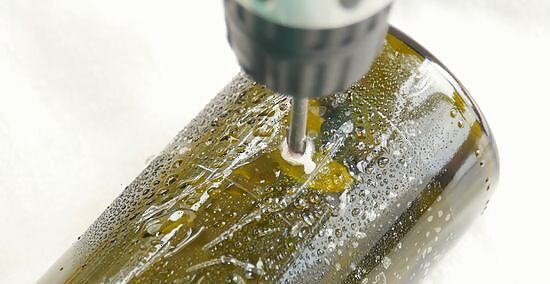
Grip the neck of the bottle and make a small pilot hole with the drill. Hold the bottle securely by the neck and align the pointed tip of the drill bit with the center of the mark you made on the bottle so it contacts the glass at a right angle. Squeeze the trigger of the drill lightly (or use a low RPM if your drill has multiple RPM settings) and firmly but gently press the bit straight into the bottle. Keep drilling until the tip of the bit clears the interior side, re-moistening the drill site with a drop of oil or a spritz of water to keep it wet and cool every 10 seconds. Wear cut-proof gloves, a face mask, and eye protection to limit your exposure to potentially-irritating dust particles. Never attempt to drill tempered glass, which is designed to shatter under stress and may cause serious injury.
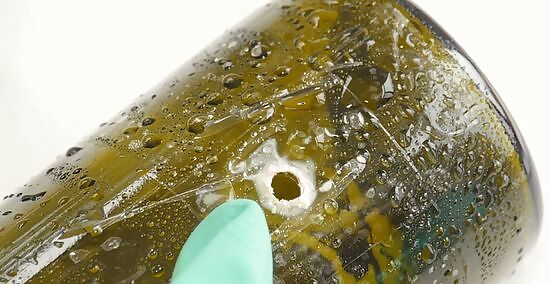
Attach a larger bit and drill again to widen the hole to the desired size. Replace your drill bit with the next available size up. Perform your follow-up rounds of drilling the same way you did the first, positioning the bit perpendicularly with the bottle and guiding it straight in with light-to-moderate pressure. When you’re done, you’ll have a nice, clean hole to show for your efforts. It’s not usually necessary to change bits more than 2 or 3 times. If your hole needs to be especially big, consider using a hole cutting bit.
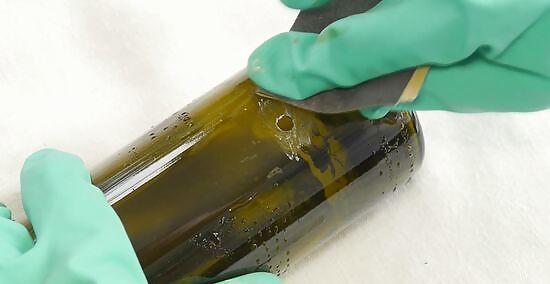
File or sand the inner edges of larger holes to smooth them out. When you’re satisfied with the size of your hole, remove the tape from the bottle and insert a file or some 100-grit sandpaper wrapped around an awl or similar tool into the hole and work your way around the edges. This wears down any sharp or jagged edges that could pose a safety risk. When you’re done, thoroughly rinse the bottle under a faucet to clear away any glass dust or chips. Optionally, install a rubber grommet into the hole to protect things you might be feeding through it for your crafts, like rope or electrical cords.
Making a Hole Without a Drill

Twist a tapered file or drill bit into the glass by hand. Dip the tip of a tapered file into oil. Then, press the tip firmly and perpendicularly into the glass bottle, where you want to bore a hole. Turn the file clockwise, then counterclockwise repeatedly, applying firm pressure to the surface of the bottle. Keep the file lubricated with oil, and work until you’ve bored a hole through the glass. This method is the manual version of using a drill. It’ll take a bit longer and require more elbow grease, but will have much the same result. Alternatively, use a carbide or diamond drill bit with your hands rather than a drill.
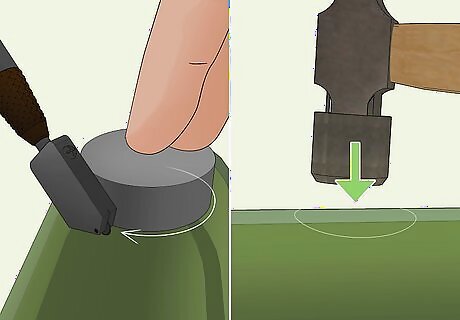
Score a hole with a glass cutter and knock the glass out. A glass cutter is a small handheld tool specially designed to score glass. Hold a guide up to your bottle, like a bottle cap or other round object the size of your desired hole. Then, press the tip of the glass cutter to the bottle and gently but firmly trace your guide across the glass surface, listening for a scratching noise to indicate you're making a cut. Then, use a solid, heavy object like a ball-peen hammer to tap the scored circle, knocking it out of the glass. Cover the glass around the hole you’ll cut with duct tape to prevent accidental cracks. Glass cutters are most often used on flat surfaces, and may not be ideal for a rounded bottle. They’re also prone to shattering the glass if not used properly.
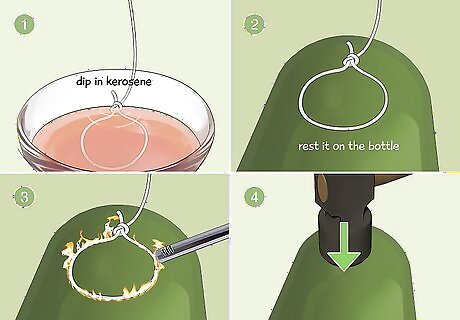
Burn a circle of string dipped in kerosene to melt through the glass. Tie a bit of cotton string into a circle the size of the hole you want to make. Then, soak the string in kerosene and rest it on the bottle where you want your hole. Holding the bottle steady, use a lighter to light the string on fire, and let it burn for 2-3 minutes to heat and weaken the glass. Finally, use the heavy handle of a butter knife or a ball-peen hammer to knock the area inside the circle of string, causing it to fall away. This method is a fun science class experiment, but is most often used to cut bottles in half, and may have mixed results when used for cutting holes.
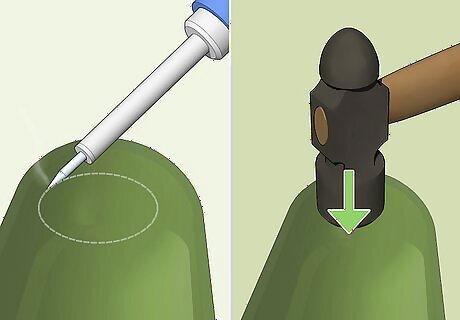
Trace a hole with a soldering iron. In a pinch, use a hot soldering iron to trace a hole into your bottle, melting the glass along a circular path. Then, punch out the glass with the handle of a butter knife or a ball-peen hammer. This method tends to be time consuming and less precise than others, and still requires a specialized tool, which is why we don’t recommend it over using a drill.




















Comments
0 comment